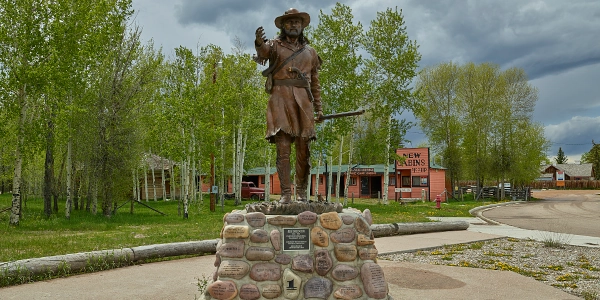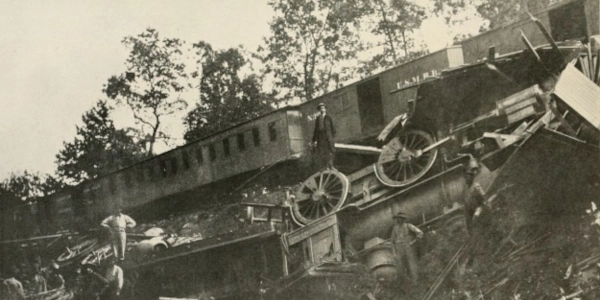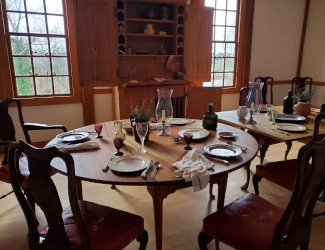
Image above: Interior of Dining Room in the Ferry Farm house. Courtesy America's Best History.
Spotlight on Lesser Known History
Ferry Farm, Virginia
America's Best History Spotlight
On this page we're going to Spotlight the lesser known historic sites and attractions that dot the history landscape across the USA and are worth a visit if you're in their area. And while they may be lesser known, some are very unique, and will be that rare find. You'll be, at times, on the ground floor, or maybe even know something others don't. It'll be fun. Visit them.
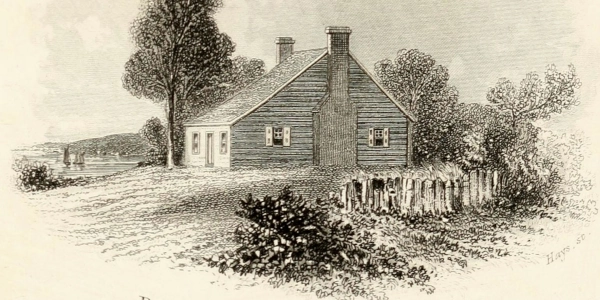
Ferry Farm, Virginia
On the other side of the Rappahannock River sits two amazing historic sites; one having to do with the Civil War battle of Fredericksburg 1862 called Chatham Manor, and the other, reaching back to the days of George Washington and his family, Ferry Farm. George lived there from the time he was a boy of six until he was twenty years old and working as a surveyer. His mother Mary raised six children there from 1738 with her husband Augustine, and continued raising them alone and running the plantation from Augustine's death in 1743. She lived there until 1772. Photo above: Washington Ferry Farm home, 1860, Hays, George Washington biography by Washington Irving. Courtesy Wikipedia Commons via Archive.org.
Sponsor this page. Your banner or text ad can fill the space above.
Click here to Sponsor the page and how to reserve your ad.
Info, What's There Now, History Nearby
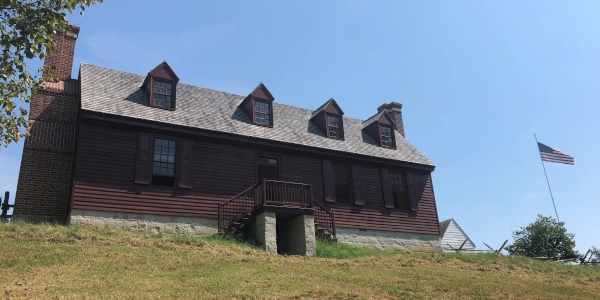
Ferry Farm, Virginia
Yes, this was a slave plantation in the northern section of the antibellum south. Their home, however large at the time, was not spectacular, but functional and showed that his father had been successful. Today you can visit the grounds, Visitor Center, and reconstructed home and learn more about the story of young George. The stories of many of our youth; that he could not tell a lie after chopping down a cherry tree with a new ax, and others, come from his time at Ferry Farm. Today, it's sixty-eight acres look much the same as they did, particularly from the bluff overlooking the Rappahannock River and site of the past ferry to town. It had been a busy place for commerce and travelers.
Image above: Front of the reconstructed Ferry Farm house which faced the Rappahannock River, 2019, aamarcian. Courtesy Wikipedia Commons, C.C. 4.0. Below: Montage of (left) Augustine Washington, 1867, part of a lithograph by John C. McRae from drawing by G.G. White. Courtesy Wikipedia Commons via picturehistory.com. (right) Mary Washington, mother of George, 1786, Robert Edge Pine. Courtesy Wikipedia Commons via Library of Congress.
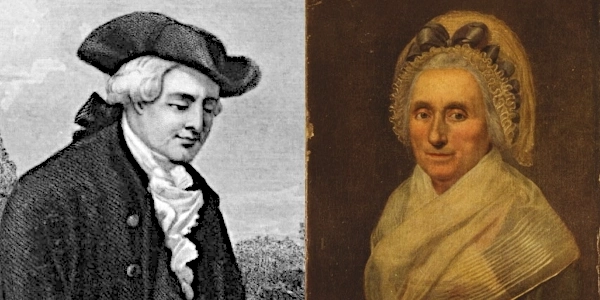
Where Is It
Ferry Farm is located at King's Highway, Fredericksburg, Virginia, 22405 at the intersection of Ferry Road and King's Highway. This is across the river from Fredericksburg and very near to Chatham Manor of the Fredericksburg Battlefield. Take Route 3 east across the river, turn left onto King's Highway, or just tell your GPS where you're going.
Minute Walk in History - Ferry Farm
Take a late fall walk around the boyhood home of George Washington, Ferry Farm, across the Rappahannock River from Fredericksburg, Virginia. A visitor center awaits, plus the grounds to the river, and a recently reconstructed home that the Washington's family lived in under his parents Augustine and Mary. Last picture in the video of George and Martha Washington dancing would not have happened at Ferry Farm, but foreshadows their days at Mount Vernon.
What is There Now
Ferry Farm
Sixty-eight acres of the property still remains of the original five hundred and eighty acres; the property originally stretching across King's Highway. There is a federal style Visitor Center with exhibit, programs, and facilities. Outside there are gardens and work fields, the reconstructed Ferry Farm house as well as a path that navigates through the land. The ferry, which the property took its name, no longer exists, but did run, for free, from the north side of the Washington property along the Rappahannock River. They neither owned or operated it.
There are indoor tours of the Ferry Farm house by a guide every hour, which walks you from the Visitor Center to the house then through its two floors. Photo below: Young George Washington as a boy, in this political cartoon, with Grover Cleveland, Daniel Manning, William C. Whitney, William F. Villas, and Lucious Q.C. Lamar with Daniel Lamont on the telephone, 1880-1900, George Yost Coffin. We do not know the context of the cartoon. Courtesy Library of Congress.
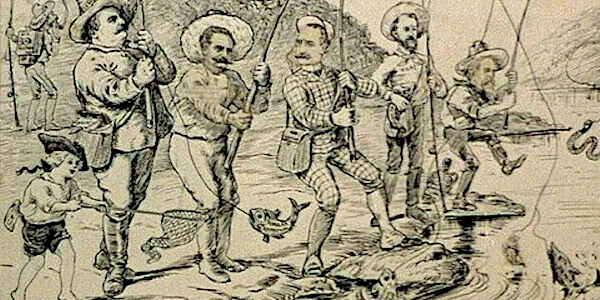
When Open and How Much
Ferry Farm is open all days of the week from March to December. The charge is currently, as of December 2022; $12 Adult, $6 Student, and free child (5 & under). Other discounts may apply.
Fees and hours are subject to change.
Websites
Ferry Farm
History Nearby
Fredericksburg is replete with history, starting with the various homes of the Washington's, i.e. Ferry Farm and Kenmore, but perhaps most known as the home of Fredericksburg and Spotsylvania National Military Park run by the National Park Service. It is not far from many other sites, i.e. Mount Vernon, and since it is about forty-five minutes south of Washington, D.C., depending on the traffic, all that the capital city has to offer. Downtown Fredericksburg is a joy to visit for other pursuits with trendy eateries, pubs, and shops.
Photos, History, and More Spotlights
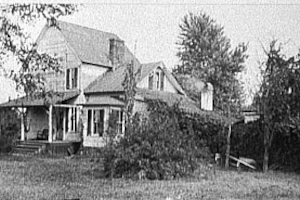
Ferry Farm History
The first European settlement of the land of Ferry Farm was in 1666 by a man named John Catlett, who had gained a land patent for a large tract. It was subdivided over the next fifty years with Augustine Washington buying the portion known as Ferry Farm in 1738 from William Strother. Augustine was already a profitable businessman, owning part of Accokeek Furnace six miles away, as well as other plantations. One of those was Mount Vernon (Little Hunting Creek), where they had just lived; another, Pope's Creek had been George's birthplace and is now a National Park Service site.
Ferry Farm was used to grow tobacco, corn, and wheat. Despite tobacco being the best cash crop in Virginia at the time, land along the Rappahannock River was poor to grow that crop and it became less of the staple of Ferry Farm as the year went by.
Augustine Washington had built the original house in 1738, now reconstructed. It was fifty-four feet wide and twenty-eight feet deep, quite large for the time period. Young George, as he grew, became a surveyor at age sixteen, and did not really appreciate Ferry Farm due its busy location. He would acquire two thousand acres by the time he could legally own Ferry Farm.
George Washington moved permanently to Mount Vernon in 1754. The Washington Ferry Farm house had been the second built on the property and was in poor condition by 1833. There would be three more structures built on the farm during its lifetime.
Photo above: Ferry Farm, circa 1900-1920. Courtesy Library of Congress.
Buy Second Edition
America's Best History Timeline

Great book to keep your youngsters up to date on their history and prepared for that Spring Break interview by Jesse Watters or another man or woman on the street reporter.

Life After Ferry Farm
By the time Washington had moved permanently to Mount Vernon in 1754, he had already gotten a commission to join the Virginia Militia at the suggestion of brother Lawrence, who owned Mount Vernon at the time. For two years, Washington was head of one of four militia districts, and had joined parties, as special envoy, in 1753, to demand the French leave what thought British Territory in the Ohio Valley. Once he arrived, they refused. However, that would not end the subject.
Washington would become lietenant colonel of the three hundred man Virginia Militia in February 1754, second in command and ordered by Lt. Governor Robert Dinwiddie to confront the French. This would lead to the battle of Fort Necessity. The French and Indian War had begun.
At the age of twenty-six, George Washington married Martha Dandridge Custis, a widow, in 1759, still working for the British in their attempt to end the final French and Indian War. They were happily married, it is said, but had no children together, raising her children and grandchildren from her previous marriage. He had inherited Mount Vernon wholly when his half-brother Lawrence passed in 1752.
Photo above: Martha and George Washington dancing at Mount Vernon after George moved there in 1754, 1904, Sherman-Brown Shoe Co. Courtesy Library of Congress. Below: President George Washington. Courtesy National Archives.


Slavery at Ferry Farm
Slavery had unfortunately been a part of the culture of Virginia since 1619 and that was true of Ferry Farm as well. There were twenty slaves on the property at the time of Washington's upbringing, some working in the fields and others in the house and gardens. There were also seven other slaves who worked other properties that Augustine and Mary owned.
Some of the slaves lived in the Ferry Farm house, as well as traveling guests once Augustine had died and Mary ran the plantation. When Mary moved into town in 1772, George Washington sold Ferry Farm.
Photo above: Guest room at Ferry Farm House, 2022, America's Best History. Below: Gardens, outbuildings, and stockade in front of Ferry Farm House, 2022, America's Best History.
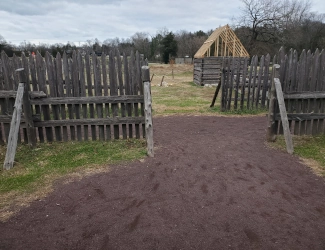

T-Shirts and Gifts from the official souvenirs of Americasbesthistory.com.
About
America's Best History where we take a look at the timeline of American History and the historic sites and national parks that hold that history within their lands.
Photos courtesy of the Library of Congress, National Archives, National Park Service, americasbesthistory.com and its licensors.
- Contact Us
- About
- © 2025 Americasbesthistory.com.
Template by w3layouts.
